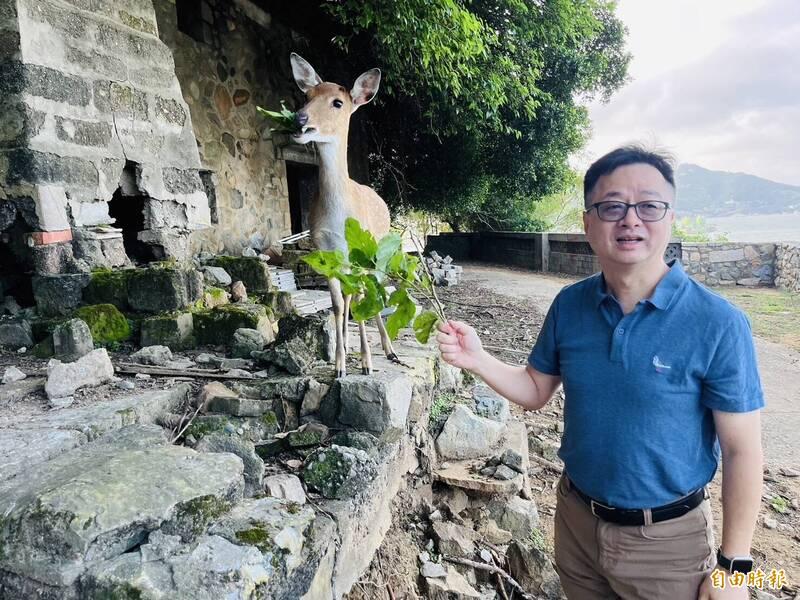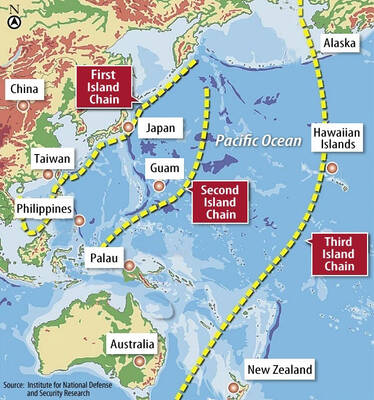The Straits Exchange Foundation (SEF) today said it is to give two Formosan sika deer to the Fuzhou Zoo as an olive branch to China, following military exercises by the Chinese People's Liberation Army on Monday.
While visiting Daciou Island (大坵) in Lienchiang County (Matsu), SEF Secretary-General Luo Wen-jia (羅文嘉) announced that the foundation is to coordinate with the Association for Relations Across the Taiwan Strait (ARATS), a subsidiary of China’s Taiwan Affairs Office, to exchange the two animals.

Photo: Chen Yu-fu, Taipei Times
The deer are named He He (和和) and Ping Ping (平平), a play on the word for “peace” (heping, 和平), Luo said.
Luo said that despite the differences in history, perception and understanding of the current situation, both sides of the Strait must seek common ground to resolve issues peacefully, rather than resort to hatred or violence.
These “deer of peace” would eventually give birth to fawns and continue to symbolize harmony in the future, Luo said.
They represent the aspirations and values of Taiwanese: hardworking, kind and passionate, Luo added.
Taiwan hopes to cooperate with China and its people over democracy, prosperity and peace, rather than provoke a war, as both sides have suffered aggression at the hands of outside powers and should seek to avoid such actions in the future, Luo said.
Luo referenced how in 2008, China gave Taiwan two pandas named Tuan Tuan (團團) and Yuan Yuan (圓圓), which was followed up with another animal exchange in 2013 of orangutans and red pandas.
If the two sides cannot resolve political issues, the animals are a good way to start and promote peace, he added.
Meanwhile in an interview, Luo said that the so-called “1992 consensus” does not exist and cannot be used as the foundation for cross-strait exchanges.
The “1992 consensus” — a term that former Mainland Affairs Council chairman Su Chi (蘇起) in 2006 admitted making up in 2000 — refers to a tacit understanding between the Chinese Nationalist Party (KMT) and the Chinese Communist Party (CCP) that both sides of the Taiwan Strait acknowledge that there is “one China,” with each side having its own interpretation of what “China” means.
If the KMT and CCP both understand it to mean that there is only “one China,” then this does not align with mainstream public opinion in Taiwan, Luo said.
Accepting the "1992 consensus” would mean that the Republic of China would not exist, he added.
The best foundation for cross-strait engagement is the more than 20 preexisting agreements signed between the SEF and ARATS, Luo said, adding that none of those agreements mention the “1992 consensus."
If these agreements are not abided by, such as issues around Taiwanese arrested in China, then subsequent political agreements would be difficult to negotiate, he said.
Chinese President Xi Jinping’s (習近平) “1992 consensus” is essentially a version of “one country, two systems” for Taiwan, he said, adding that the KMT’s own formulation of “one country, two systems” no longer includes the words “respective interpretation,” as seen by former president Ma Ying-jeou’s (馬英九) meeting with Xi in April.
Even without the “1992 consensus” or a new formulation, cross-strait talks are still possible on the basis of equality and dignity, he added.

An alleged US government plan to encourage Taiwan Semiconductor Manufacturing Co (TSMC) to form a joint venture with Intel to boost US chipmaking would place the Taiwanese foundry giant in a more disadvantageous position than proposed tariffs on imported chips, a semiconductor expert said yesterday. If TSMC forms a joint venture with its US rival, it faces the risk of technology outflow, said Liu Pei-chen (劉佩真), a researcher at the Taiwan Industry Economics Database of the Taiwan Institute of Economic Research. A report by international financial services firm Baird said that Asia semiconductor supply chain talks suggest that the US government would

WANG RELEASED: A police investigation showed that an organized crime group allegedly taught their clients how to pretend to be sick during medical exams Actor Darren Wang (王大陸) and 11 others were released on bail yesterday, after being questioned for allegedly dodging compulsory military service or forging documents to help others avoid serving. Wang, 33, was catapulted into stardom for his role in the coming-of-age film Our Times (我的少女時代). Lately, he has been focusing on developing his entertainment career in China. The New Taipei District Prosecutors’ Office last month began investigating an organized crime group that is allegedly helping men dodge compulsory military service using falsified documents. Police in New Taipei City Yonghe Precinct at the end of last month arrested the main suspect,

Starlux Airlines on Tuesday announced it is to launch new direct flights from Taiwan Taoyuan International Airport to Ontario, California, on June 2. The carrier said it plans to deploy the new-generation Airbus A350 on the Taipei-Ontario route. The Airbus A350 features a total of 306 seats, including four in first class, 26 in business class, 36 in premium economy and 240 in economy. According to Starlux’s initial schedule, four flights would run between Taoyuan and Ontario per week: Monday, Wednesday, Friday and Saturday. Flights are to depart from Taoyuan at 8:05pm and arrive in California at 5:05pm (local time), while return flights

LITTORAL REGIMENTS: The US Marine Corps is transitioning to an ‘island hopping’ strategy to counterattack Beijing’s area denial strategy The US Marine Corps (USMC) has introduced new anti-drone systems to bolster air defense in the Pacific island chain amid growing Chinese military influence in the region, The Telegraph reported on Sunday. The new Marine Air Defense Integrated System (MADIS) Mk 1 is being developed to counter “the growing menace of unmanned aerial systems,” it cited the Marine Corps as saying. China has constructed a powerful defense mechanism in the Pacific Ocean west of the first island chain by deploying weapons such as rockets, submarines and anti-ship missiles — which is part of its anti-access/area denial (A2/AD) strategy against adversaries — the